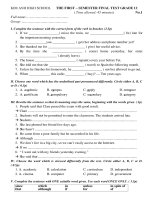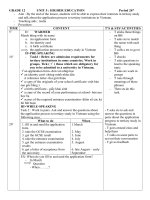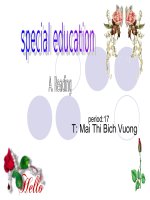Multicultural education presentation final
Bạn đang xem bản rút gọn của tài liệu. Xem và tải ngay bản đầy đủ của tài liệu tại đây (5.52 MB, 54 trang )
Multicultural Education
Professional Learning
Full Session Outline
Introduction
Your Perspective
Terms
Multicultural Education
Cultural Responsiveness
Closing Reflection
2
Introduction
3
PURPOSE
Increase awareness and
respect for ALL
differences, through
multicultural education.
4
WV CODES & POLICIES
WV State Code
§18-5-5a:
Study of Multicultural Education for School Personnel
WV Board of Education Policies
Policy 2315:
Comprehensive School Counseling Program
Policy 2320:
A Process for Improving Education
Policy 2322:
Standards for High Quality Schools
Policy 2510:
Assuring the Quality of Education: Regulations for Educational Programs
Policy 2520.19
WV College- and Career- Readiness Dispositions and Standards for Student Success Grades K-12
Policy 4373:
Expected Behavior in Safe and Supportive Schools
WV Board of Education Strategic Plan
Core Values
Evaluation Standards
Teacher:
Standard 2 - The Learner and the learning Environment; Element 2.1, Element 2.2
Standard 3 - Teaching; Element 3.3
Standard 4 Professional Responsibilities for Self-Renewal; element 4.1
Counselor:
Standard 2 - Program Delivery; Element 2.1, Element 2.3, Element 2.4, Element 2.5
Standard 4 - Leadership and Advocay; Element 4.1
Standard 5 Professional Growth and Responsibilities; Element 5.1, Element 5.2
Administrator:
Standard 4 - Positive Learning Climate and Cohesive Culture; Element 4
Standard 5 - Professional Growth and Retention of Quality Staff; Element 5
Standard 6 - Support Systems for Student Success; Element 6
5
Student Success Standards
• Global Citizenship
• DSS.K-2.14-15:
• Understand and describe the interactive roles and relationships
among family members and classroom community.
• Identify self as a member of groups within a community.
• Understand similarities and respect differences among people, such as
gender, race, disability, culture, language, and family structure.
• DSS.3-5.14-15:
• Investigate and respect aspects of various communities and discuss
how these contribute to each individual’s perspective of local, state,
and world events.
• Identify themselves as members of varied groups within the local,
state, national, and international community.
• Interact respectfully with all individuals regardless of gender, race,
disability, culture, language, and family structure
6
Student Success Standards
• Global Citizenship
• DSS.6-8.14-15:
• Compare and contrast aspects of various communities and describe
how these contribute to each individual’s perspective and world view.
• Analyze factors that contribute to different social and world views (e.g.,
ethnicity, race, culture, gender, sexual orientation, family composition,
lifestyle, religion, economic status and nationality).
• Apply an inter-culturally sensitive perspective to social interactions.
• Describe global issues and events from perspectives of various
individuals and groups to understand viewpoints other than one’s own.
• Investigate methods for enhancing language proficiency and the ability
to communicate effectively across cultural and linguistic boundaries.
• Describe how stereotyping and prejudices impact interpersonal
relationships.
7
Student Success Standards
• Global Citizenship
• DSS.9-12.14-15:
• Describe how the characteristics of diverse world regions and
individual communities contribute to varying world views.
• Investigate and explain how factors such as ethnicity, gender,
religion, sexuality, and economic conditions contribute to
different social and world views.
• Analyze global issues and events to gain an understanding of
others’ viewpoints.
• Analyze language, behavior, and non-verbal communication
cues to interact respectfully with diverse cultures.
• Examine the influence of stereotyping and prejudice and how
they impact relationships.
8
Diversity Makes Us Different
Primary Dimensions of
Diversity
Age
Race
Ethnicity
Heritage
Gender
Physical abilities/qualities
Sexual/affection orientation
Mental
abilities/characteristics
Secondary Dimensions
of Diversity
Education
Communication style
Work background
Work style
Income: Wealth/Poverty
Marital status
Military experience
Religious beliefs
Geographic location
Parental status
10
ACTIVITY
Name 5 Things
List 5 things about you,
that if taken from you,
you would not be the
same person you are
today.
11
Consider the Students
When we ask students to
remove aspects of
themselves to accommodate
our teaching or schools, we
are disabling their ability to
learn and achieve at full
capacity.
12
Terms
13
ACTIVITY
Defining Terms Used in Multicultural
Education
Culture
Diversity
Ethnicity
Race
Multicultural Education
Cultural
Responsiveness
Cultural Proficiency
Global Competence
Tolerance
Bias
Stereotype
Equity
Equality
14
Equality vs. Equity
• Equality means giving each
student the same resource.
• Educational equity means
that every student has
access to the resources and
educational rigor they need
at the right moment in their
education, despite race,
gender, ethnicity, language,
family income, family
background, or disability.
Your Perspective
16
The Culture of Schooling
20th Century
Tolerance
Factory Model
Top Down
Silos
Gatekeepers
Intervention Programs
Deficits
“Old School”
Diversity Training
21st Century
Transformation
Inclusive Systems
Collaborative/Co-Creative
Leadership Teams
Agents of Change
School-Wide Support/Prevention
Assets
Multiple Perspectives
Cultural
Proficiency
Adapted
from Diana Practices
L. Stephens, Ph.D.
17
ACTIVITY
The Culture of Schooling
1. Compare and contrast one of the following 20th and 21st
century culture of schooling aspects:
Factory Model vs. Inclusive System
Top Down vs. Collaborative/Co-Creative
Gatekeepers vs. Agents of Change
Intervention Programs vs. School Wide
Support/Prevention
Deficits vs. Assets
“Old School” vs. Multiple Perspectives
2. Identify the pros and cons of the 20th and 21st century
culture of schooling aspects they have chosen.
3. Determine if your building (administrator), classroom
(teacher/others) or office (counselors, nurses, etc.)
represents 20th or 21st century culture of schooling.
18
Multicultural Perspectives
¨
Windows
¨
Mirrors
19
ACTIVITY
First Impressions…Who Are They?
Write down your
thoughts and
impressions
regarding the
individual or
groups of
individuals on the
next eight slides.
20
ACTIVITY
21
ACTIVITY
22
ACTIVITY
23
ACTIVITY
24
ACTIVITY
25









